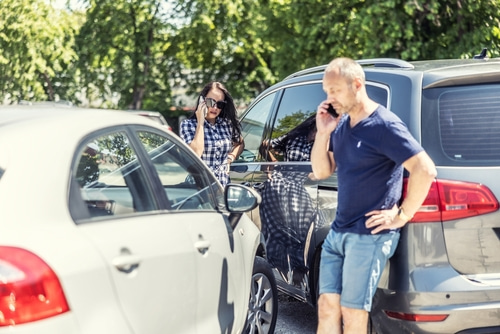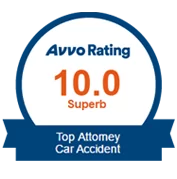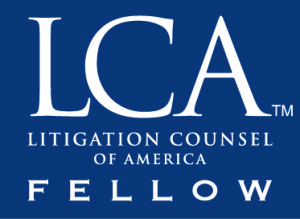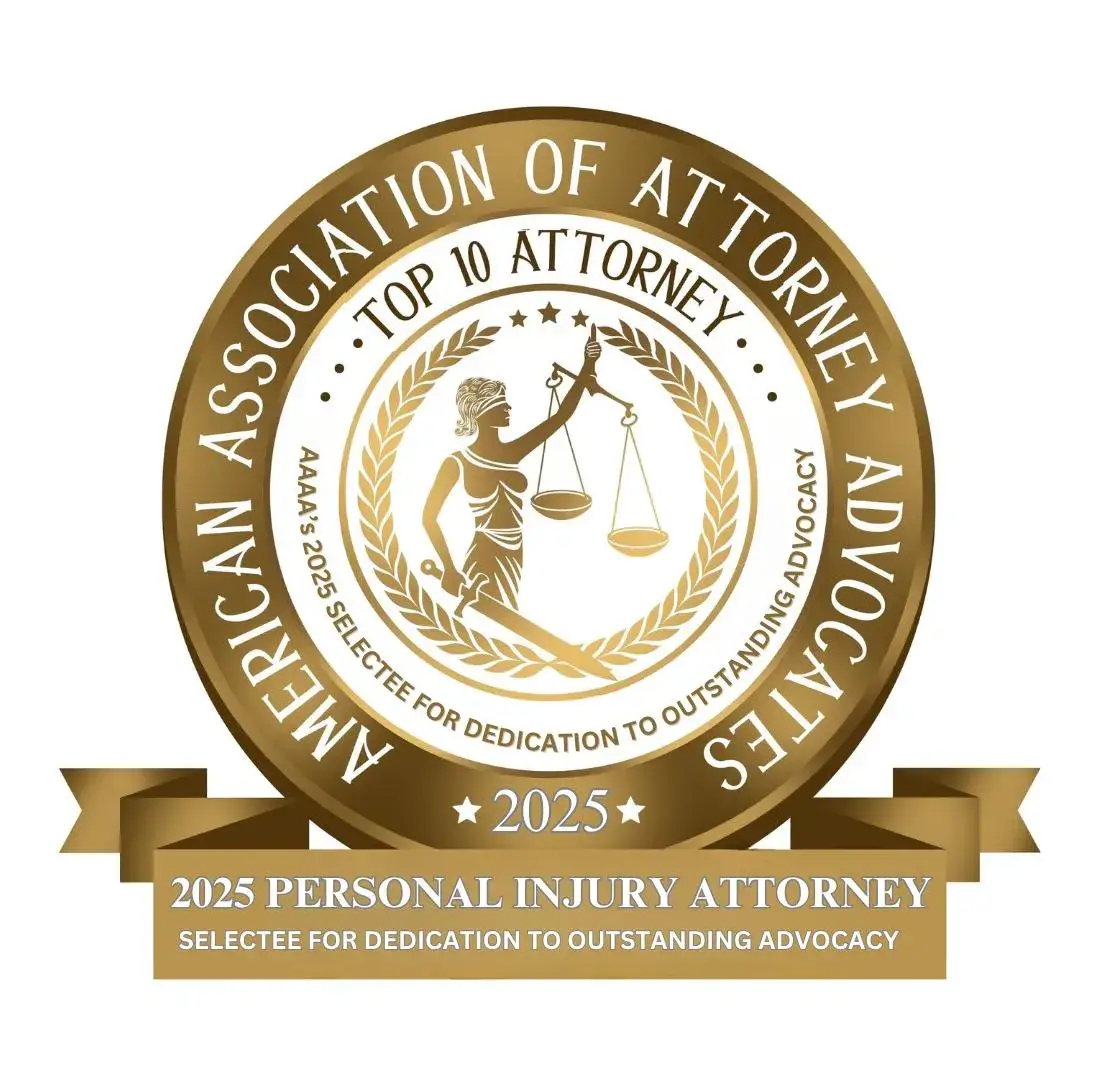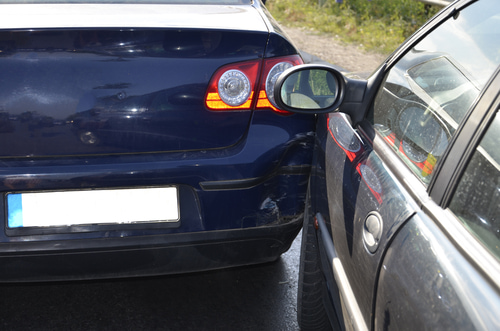
What Is a Sideswipe Collision?
Sideswipe collisions occur when two vehicles traveling in the same or opposite direction make contact along their sides. These incidents often happen during lane changes, merges, or when one vehicle drifts out of its designated lane.
While some sideswipe accidents result in minor damage, others lead to severe injuries, especially when high speeds or large vehicles are involved. Drivers, passengers, pedestrians, and cyclists may all be affected, and the path to compensation depends on how fault is determined and how promptly the incident is reported.
If you were injured in a sideswipe crash, a car accident lawyer can help you understand your legal options, deal with uncooperative insurance companies, and pursue fair compensation for medical bills, vehicle repairs, and other losses.
What is a sideswipe collision?
- A sideswipe accident happens when two vehicles traveling side-by-side make contact, often during unsafe lane changes or merging.
- Common causes include distracted driving, blind spot errors, improper merges, or aggressive behavior on highways or city streets.
- Fault is determined through evidence like police reports, dashcams, witness statements, and vehicle damage patterns.
- Injuries can be serious, ranging from whiplash and spinal trauma to traumatic brain injuries and long-term psychological effects.
- New Jersey and New York laws apply comparative fault rules, which may impact how much compensation a victim can receive.
Common Causes and Types of Sideswipe Collisions
Many sideswipe collisions occur because one driver failed to observe surrounding traffic or misjudged the distance between vehicles. The root causes of these incidents typically involve human error, distracted behavior, or road design factors that increase the chance of contact.
Typical Scenarios Involving Sideswipes
Most sideswipe collisions can be traced back to one of the following situations:
- Unsafe lane changes. Drivers who fail to check blind spots, signal properly, or yield to vehicles already occupying a lane can make contact while attempting to merge or pass.
- Distraction or inattention. A vehicle may drift into an adjacent lane due to cellphone use, fatigue, or visual distractions.
- Highway merging or exits. Merging onto or off a highway involves multiple vehicles adjusting speed and positioning. Misjudging space or merging too quickly can result in side-to-side contact.
- Urban driving conditions. In cities like New York, limited lane widths, frequent turns, and heavy congestion increase the risk of sideswipe incidents, particularly when larger vehicles or buses are involved.
- Impaired or aggressive driving. Drivers under the influence or exhibiting road rage may veer into other lanes deliberately or carelessly.
Commercial Vehicles and High-Risk Roadways
Due to their size and weight, sideswipe collisions involving commercial trucks, buses, or delivery vehicles can cause more significant damage. When a smaller car is sideswiped by a commercial truck, the impact can push the car into adjacent lanes, guardrails, or other vehicles. These accidents often occur on highways like the New Jersey Turnpike, I-95, or the George Washington Bridge corridor, where dense traffic and high speeds amplify the consequences.
When a commercial vehicle is involved, the legal analysis often includes employer liability, driver qualifications, logbook inspections, and compliance with federal safety regulations. These factors introduce additional legal considerations that may require formal investigation.
How Is Fault Determined in a Sideswipe Collision?
Fault determination in a sideswipe collision is rarely automatic. Insurance companies and courts review multiple types of evidence to decide whether one or both drivers contributed to the accident. In some cases, liability may be shared under the legal doctrine of comparative negligence.
Legal Standards for Liability in a Sideswipe Accident
In New Jersey and New York, drivers are legally obligated to operate their vehicles responsibly. When a driver changes lanes without signaling or checking for other cars, this may constitute a breach of that duty. The same applies to drivers who veer into adjacent lanes or fail to maintain a consistent lane position.
New Jersey applies a modified comparative negligence rule. Under this standard, a party over 50 percent at fault cannot recover compensation. If a driver is found to be 30 percent at fault, any damages awarded will be reduced by that percentage.
New York follows a pure comparative negligence model. This means a party can recover damages even if they are up to 99 percent at fault, although the award will be reduced in proportion to their degree of responsibility.
These state-specific rules significantly affect whether compensation is available and how much a claimant may receive.
Key Evidence Used in Fault Analysis
Establishing liability in a sideswipe accident depends on collecting objective, time-sensitive evidence. The following items may be considered when determining fault:
- Police reports. Officers often record statements from both drivers, assess vehicle damage, and issue citations. These reports can influence how insurers assign fault, though they are not conclusive in civil court.
- Photographs and video. Pictures showing skid marks, vehicle positions, or lane markings can support a party’s version of events. Dashcam footage and surveillance videos from nearby businesses can also provide valuable context.
- Witness statements. Neutral witnesses can describe the vehicle movements before impact, helping to clarify whether one driver drifted or attempted an unsafe maneuver.
- Vehicle damage. Both vehicles’ location and damage pattern may indicate lane departure or the point of initial contact. For example, damage concentrated along the side panel of one vehicle and the front corner of another may suggest an aggressive merge.
- Traffic citations. A ticket for improper lane usage, failure to yield, or distracted driving may support a negligence claim.
Each of these factors contributes to a broader legal picture. When fault is disputed, the quality of evidence can determine whether an insurer accepts or denies the claim, or whether a lawsuit proceeds to trial.
Injury Claims in Sideswipe Accidents
While sideswipe accidents may appear minor, the injuries sustained can be significant. The angle of impact and resulting vehicle movements may cause occupants to be jolted, thrown sideways, or struck by debris.
Common Injuries and Their Legal Relevance
Injury claims often involve one or more of the following conditions:
- Whiplash. A sudden lateral or rearward motion can strain the neck and upper spine, even at moderate speeds.
- Soft tissue injuries. Sprains, muscle tears, and contusions are common and may require physical therapy.
- Traumatic brain injuries (TBI). A blow to the head or violent head motion can lead to concussions or more serious brain injuries.
- Spinal injuries. Compression fractures, herniated discs, or nerve impingements can result in long-term pain and functional limitations.
- Psychological trauma. Anxiety, sleep disturbances, and fear of driving may arise after a traumatic collision.
These injuries may not be visible immediately after the incident, but symptoms often develop over hours or days. Prompt medical evaluation is important for health reasons and to create a documented record supporting legal recovery.
How Injuries Affect Legal Damages in Sideswipe Collisions
The severity of injury plays a direct role in determining legal damages. A claimant may seek compensation for:
- Medical expenses. Hospital bills, follow-up visits, medications, and rehabilitation.
- Lost income. Time away from work or a reduced ability to perform job duties.
- Pain and suffering. Physical discomfort and reduced quality of life.
- Future care needs. Ongoing therapy, surgical interventions, or medical devices.
- Property damage. Repairs or replacement costs for the damaged vehicle.
In cases involving permanent disability or long-term treatment, economic experts may be retained to project future losses. These projections can significantly affect settlement negotiations or trial awards.
What is the Insurance Claims Process for Sideswipe Collisions?
The insurance process begins once the accident has been reported and immediate safety concerns addressed. Depending on the fault, a driver may file a claim through their own insurer or the at-fault driver’s liability policy.
Reporting the Accident and Filing a Sideswipe Claim
Most insurance policies require prompt notice of any incident that may give rise to a claim. In New York and New Jersey, failure to report within a reasonable time may lead to a denial of coverage, even if the policyholder was not at fault.
If you are not responsible for the accident, you may still need to report the collision to your insurer to:
- Satisfy the terms of your policy.
- Access first-party benefits like Personal Injury Protection (PIP) or MedPay.
- Trigger a potential subrogation action if your insurer later seeks reimbursement.
A third-party claim may also be filed directly with the other driver’s insurance provider. This claim typically seeks compensation for vehicle repairs, injuries, and related costs.
Common Challenges During Claims
Insurance companies may attempt to reduce payouts or shift responsibility even when liability appears clear. Common challenges include:
- Disputes over fault. Insurers may claim that both drivers contributed to the collision.
- Request for recorded statements. Adjusters may attempt to elicit statements that reduce claim value.
- Delays or denials. An insurer may delay investigation or issue a denial based on insufficient evidence.
If you experience any of these issues, it may be time to seek legal representation to protect your interests and pursue fair compensation.
How Comparative Negligence Affects Sideswipe Accidents
Comparative negligence is the legal principle allowing multiple parties to share fault in an accident. This standard is especially relevant in sideswipe collisions, where drivers may claim the other drifted or merged improperly. The allocation of fault influences how much compensation, if any, a person can recover.
Comparative Fault Laws in New Jersey and New York
New Jersey follows a modified comparative negligence model. Under this rule, a person may recover damages only if they are found 50 percent or less at fault. If a claimant is assigned 51 percent or more of the responsibility, they are barred from financial recovery.
On the other hand, New York applies a pure comparative negligence rule. This allows a party to seek damages even if they are predominantly at fault. The total compensation will be reduced in proportion to the claimant’s share of fault.
The application of comparative negligence often arises in insurance negotiations and trial proceedings. Legal teams may dispute percentages aggressively, as even a 10 percent shift in liability can result in significant financial differences.
How Shared Fault Affects Settlement or Verdict Value
When both drivers share responsibility, insurers use the assigned percentages to adjust claim payouts. For instance, if both drivers are found to be equally at fault, each may be entitled to recover half the value of their total losses. However, if one party crosses the 50 percent threshold in New Jersey, that individual may receive nothing.
These percentages can become points of leverage in settlement negotiations. Insurers may allege partial fault to reduce their financial exposure, while claimants seek to prove that the other driver bears most responsibility. This is why evidence and structured legal arguments matter, especially in states where the threshold for disqualification is relatively low.
Legal Timelines After a Sideswipe Accident
Legal rights and recovery options are subject to strict timelines. Failing to act within the allowable period can permanently bar a person from filing a claim or lawsuit, regardless of the severity of injuries or strength of evidence.
Statute of Limitations in New Jersey and New York
In New Jersey, individuals generally have two years from the accident date to file a personal injury lawsuit. The statute of limitations for property damage claims is six years.
The personal injury statute of limitations in New York is also two years. However, for property damage, the limit is three years from the date of the incident.
These deadlines have limited exceptions, such as cases involving minors or claims against public entities, which may follow a different filing process with shorter notice periods. For example, in claims against municipal authorities, a Notice of Claim may need to be filed within 90 days of the accident.
How Delays Can Impact Evidence and Claim Strength
Beyond legal deadlines, practical delays can weaken a case. As time passes, the following issues may occur:
- Witness memory fades, reducing the reliability of testimony.
- Surveillance footage may be deleted, especially if not requested promptly.
- Medical records may show gaps in treatment, which insurers can use to question injury severity.
Early action allows an attorney to secure records, preserve physical evidence, and begin negotiations before leverage is lost. Documentation and proactive steps protect future options even when someone believes they are not seriously injured.
When to Contact a Car Accident Attorney After a Sideswipe Collision
Legal representation may not be necessary for every accident. However, when disputes arise, injuries occur, or insurers delay or deny claims, legal guidance can provide structure and direction during uncertainty.
Signs That Legal Representation May Be Warranted
The following situations often indicate that attorney involvement is appropriate:
- You are being blamed for the accident despite clear evidence that another driver caused the collision.
- The insurance adjuster denies liability or issues a settlement offer far below your losses.
- Your injuries are long-term or permanent, and the financial impact is still developing.
- A commercial vehicle is involved, raising questions about employer liability or federal compliance.
- The other driver lacks insurance, and your claim requires access to uninsured motorist benefits.
Each scenario involves legal and procedural barriers that may delay recovery if handled alone.
How a Car Accident Attorney Can Help You Protect Your Rights
A car accident attorney experienced in sideswipe crashes can take over communications with insurers, collect relevant documentation, and build a legal argument for full compensation. In addition to negotiating settlements, legal counsel can:
- Identify liable parties, including employers, vehicle owners, or government entities.
- Retain qualified experts, such as accident reconstruction specialists or economic loss analysts.
- File a lawsuit before deadlines expire and prepare for trial if a fair resolution is not reached.
Being represented by a qualified car accident lawyer often leads to higher settlement offers, especially when insurers recognize that the claimant is represented and prepared to litigate.
Contact a Sideswipe Accident Lawyer Serving New Jersey and New York
If you were injured in a sideswipe accident or believe the other driver’s insurer is minimizing your claim, contact the legal team at Maggiano, DiGirolamo & Lizzi, PC.
Our skilled sideswipe accident attorneys represent injured individuals in New Jersey and New York, handling claims involving disputed fault, uninsured drivers, and severe personal injury.
Call (201) 585-9111 for a free consultation or submit a contact form online. There is no obligation, just straight answers to help you confidently evaluate your legal options.
Frequently Asked Questions About Sideswipe Collisions
Who is usually at fault in a sideswipe accident?
Fault depends on the specific facts of the case. The driver who changed lanes without yielding, drifted from their lane, or failed to maintain proper control is often considered at fault. However, under comparative fault rules, both drivers can share responsibility.
Can I file a claim if the other driver left the scene?
Yes. A sideswipe accident involving a hit-and-run may be covered by uninsured motorist protection. This coverage is required in New York and is commonly included in New Jersey policies. Promptly reporting the incident and obtaining a police report strengthens your position.
What damages can I recover after a sideswipe crash?
Recoverable damages include medical expenses, lost wages, past and future pain and suffering, property damage, and anticipated treatment costs. The availability and worth of these damages hinge on the severity of injuries, policy limits, and the level of fault involved.
How long does a sideswipe accident settlement take?
Timelines vary depending on how clear-cut the fault is, the severity of the injuries, and the insurer’s cooperation. Uncontested claims may resolve within several weeks. Disputed or complex claims can take months or proceed to litigation.
What happens if both drivers are partially at fault?
In New Jersey, recovery is barred if you are more than 50 percent at fault. You may still recover in New York, but your compensation will be reduced based on your share of the blame.




